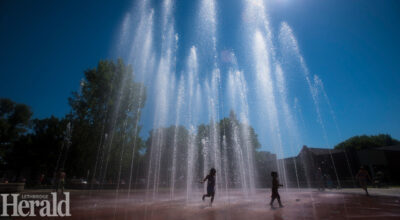SPC hears update on water conservation measures
By Al Beeber - Lethbridge Herald on February 2, 2024.
 Herald file photo -
Children run through the jet of water at the Rotary Centennial Spray Park at Galt Gardens. Lethbridge residential water consumption is said to be among the highest in Alberta.
Herald file photo -
Children run through the jet of water at the Rotary Centennial Spray Park at Galt Gardens. Lethbridge residential water consumption is said to be among the highest in Alberta.LETHBRIDGE HERALDabeeber@lethbridgeherald.com
Lethbridge residential water consumption is among the highest in Alberta behind Coaldale and Medicine Hat, the Assets and Infrastructure Standing Policy Committee of city council heard Thursday during a report on water conservation.
Director of Infrastructure Services Joel Sanchez gave a detailed report to the SPC on the current water situation in southern Alberta, efforts the province is engaged in to address the impacts of another drought and steps the City could take to mitigate the situation.
City residents use 232 litres of water per capita per day, showed a graph presented to the SPC. This is an amount slightly higher than Calgary and far above the amount consumed by residents in the provincial capital of Edmonton who use 167 l/pp/d. Medicine Hat residents are the province’s biggest water users at 339 l/pp/d followed by Coaldale at 300 l/pp/d.
The average cost monthly cost in Lethbridge for residential use of 20 cubic metres of water per month is $49.94, one of the lowest rates in the province above only Coaldale at $47.10 monthly and Calgary at $42.71 per month.
The most expensive rates are in Strathcona County at $61.40 per month followed by Edmonton at $60.66 and Medicine Hat at $56.88.
The SPC heard that more than 65 per cent of city households use less than 20 cubic metres per month and about half of city water use goes back into the Oldman River, a far higher than the amount recovered by irrigators. Total overall water consumption for 2023 was 20 cubic metres per month. Total annual Industrial, Commercial and Institutional l/pp/d in 2023 was 299. Over five years, that consumption peaked in 2020 at 304 l/pp/d.
Long-range forecasts show there is a 62 per cent chance of the warm, dry conditions brought on by the El Nino weather pattern continuing through June with a 50-60 per cent chance of above normal temperatures and minimal precipitation and snowpack.
“The reality is worse,” he said of the forecast.
“Temperatures are getting to record levels on some days and we are in a situation where we really need to start planning for the worst case scenario,” said Sanchez.
He said it’s important to create a culture to preserve water, stating this isn’t a one-time event but rather a situation that will happen over many years.
Sanchez talked about water licences and how they work, noting it’s based on seniority.
If the date the licence was granted is old, it will have priority over any other licence.
The City has some of the oldest licences in the watershed, going back to the early 1900s but irrigation districts are older, some going back to the 1890s.
They have the majority of rights but also priority when it comes to exercising their licences, the SPC heard.
Sanchez said a recent snowfall had disappeared within a week or two and snowfall is “really needed in the mountains. That’s where we need that to happen in order to make sure we can replenish the reservoirs.”
He said the province is actively communicating with licence holders with some being asked to stop taking water because of low river levels.
Effective Thursday, the province had tasked its Drought Command Team to begin negotiations with licence holders in the Oldman, Red Deer and Bow River basins.
Presently, 51 water shortage advisories are in place in Alberta.
While licence agreements are based on seniority and date, “there will be a time where that can be over-ridden by a sharing agreement where depending on the current stage of emergency, the province will be able to dictate where the use is going to go and what are those priorities. So that’s the proactive work that is starting today,” added Sanchez.
Conservation initiatives council could consider, he said, include scaling water rates like Edmonton and Okotoks do. Both communities have three tiers of rates for water consumption.
Rebates for xeriscape landscaping and rainwater irrigation systems could also be considered.
Another consideration could be metering parks irrigation systems.
Councillor Jeff Carlson pointed out to the meeting that the optics don’t look good to residents when they see sprinklers operating at parks during rainstorms.
March will be a key point because most snow hits the mountains at that time. The province has hired a water management consultant to do some monitoring and by March the city will know if water licence agreements being developed now will have to be implemented.
In May and June, the City will know exactly what water levels are and an emergency could be declared by the province at that time, he said.
27-26


